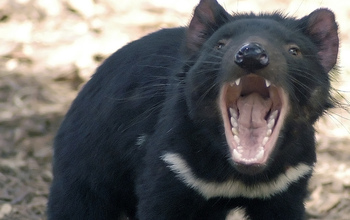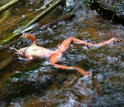 Credit and Larger Version |
facial disease; infection with antibiotic-resistant staphylococcus; foot-and-mouth disease; malaria: Is our interaction with the environment somehow responsible for the increased incidence of these diseases?
The joint National Science Foundation (NSF) and National Institutes of Health (NIH) Ecology and Evolution of Infectious Diseases (EEID) program is providing answers.
The EEID program supports efforts to understand the ecological and biological mechanisms behind human-induced environmental changes and the emergence and transmission of infectious diseases.
NSF and NIH--in collaboration with the U.S. Department of Agriculture National Institute of Food and Agriculture (NIFA) and the U.K.'s Biotechnology and Biological Sciences Research Council (BBSRC)--have awarded more than $16 million in new EEID grants.
"Our understanding of the ecology and evolution of pathogens comes from knitting together information from many different sources," says Sam Scheiner, NSF EEID program director. At NSF, EEID is funded by the Directorates for Biological Sciences, Geosciences, and Social, Economic & Behavioral Sciences.
"They include diseases of humans, frogs, honeybees and plants," says Scheiner. "Each system provides a different piece of the puzzle that helps us protect human health, the health of our agricultural systems and that of our natural world."
Projects funded through the EEID program allow scientists to study how large-scale environmental events--such as habitat destruction, invasions of non-native species and pollution--alter the risks of emergence of viral, parasitic and bacterial diseases in humans and other animals.
"This year's EEID projects bring together multiple scientific fields to address how human and natural processes influence infectious diseases in humans and other animals, including diseases that affect wildlife and agriculture, as well as those of significant public health concern in the developing world," says Christine Jessup, EEID program director at NIH's Fogarty Center.
"Findings from EEID-supported research are improving public health interventions and management decisions."
Researchers supported by the EEID program are advancing basic theory related to infectious diseases, and improving understanding of how pathogens spread through populations at a time of increasing environmental change.
The benefits of research on the ecology and evolution of infectious diseases include development of theories about how diseases are transmitted, improved understanding of unintended health effects of development projects, increased capacity to forecast disease outbreaks, and knowledge of how infectious diseases emerge and reemerge.
"Animal and plant diseases cause significant losses in food production around the globe and pose risks to human health," says Sonny Ramaswamy, NIFA director.
"As NIFA and the scientific community work toward solutions that ensure our food security, research on the evolution and spread of infectious diseases will help us understand how best to prevent, predict and respond to these threats."
This year's EEID awardees will conduct research on such topics as the emergence of Tasmanian devil facial tumor disease, honeybees and their parasites, the evolution and spread of virulent infectious diseases, the macroecology of infectious disease, and the persistence of foot-and-mouth disease.
"Tackling the infectious diseases that threaten the health of humans and livestock is a critical need, especially in the face of a growing global human population expected to reach 9 billion by 2050," says Douglas Kell, BBSRC chief executive.
"We face many challenges related to food security and health. These EEID projects will combine international expertise to help us find solutions."

The largest cause of honeybee declines is the Varroa mite, subject of an EEID award.
Credit and Larger Version

Mosquitoes: the vector for the malaria parasite Plasmodium falciparum.
Credit and Larger Version

Cape buffalo in Africa act as a host for the contagious foot-and-mouth disease virus.
Credit and Larger Version

Amphibian pathogens, such as a fungus infecting frogs, are the focus of an EEID award.
Credit and Larger Version

Do livestock practices contribute to the emergence of antibiotic-resistant bacteria?
Credit and Larger Version
EEID 2013 Grants
Andrew T. Storfer, Washington State University, Emergence, transmission and evolution of Tasmanian devil facial tumor disease
Additional Collaborators: Hamish McCallum, Griffith University; Menna Jones, University of Tasmania; Elizabeth Murchison, Wellcome Trust Sanger Institute; Paul Hohenlohe, University of Idaho
Patrick Stephens, University of Georgia, RCN Proposal: Macroecology of infectious disease
Additional Collaborators: Robert Poulin, University of Otago; Sonia Altizer, University of Georgia; Katherine Smith, Brown University; Alonso Aguirre, Smithsonian-Mason School of Conservation
Jill Stewart, University of North Carolina at Chapel Hill, The impact of intensive livestock production on the disease ecology of antibiotic resistant staphylococcus
Additional Collaborators: Jacqueline A. MacDonald, Rachel T. Noble, Marc L. Serre, Steven B. Wing, University of North Carolina at Chapel Hill
Bret Elderd, Louisiana State University, Scaling up epizootic dynamics--Linking individual infection to spatial spread of a disease using Bayesian hierarchical approaches
Additional Collaborators: Kelli Hoover, Penn State University; Michael Stout, Louisiana State University AgCenter; Vanja Dukic, University of Colorado
Cheryl Briggs, University of California-Santa Barbara, Disease in complex communities: How multi-host, multi-pathogen interactions drive infection dynamics
Additional Collaborators: Andrew R. Blaustein, Oregon State University, Jason T. Hoverman, Perdue University, Pieter T. Johnson, University of Colorado, Jason R. Rohr, University of South Florida
Jacobus de Roode, Emory University, US-UK collaboration: Understanding the effects of spatial structure on the evolution of virulence in the real world: honeybees and their destructive parasites
Additional Collaborators: Berry J. Brosi, Emory University; Keith Delaplane, University of Georgia
Wayne K. Potts, University of Utah, The evolution and spread of virulent infectious disease
Additional Collaborators: Frederick R. Adler, University of Utah; Henry D. Hunt, Michigan State University
Mercedes Pasqual, University of Michigan, The impact of seasonality and vector control on the population structure of Plasmodium falciparum
Anna E. Jolles, Oregon State University, US-UK collaboration: Persistence of a highly contagious pathogen: ecological and evolutionary mechanisms in foot-and-mouth disease virus
Additional Collaborators: Jan Medlock, Oregon State University
Alison G. Power, Cornell University, US-UK collaboration: Spatial epidemiology of a vector-borne plant virus: Interactions between landscape, hosts, vectors and an emerging disease of potatoes
Additional Collaborators: Laura E. Jones, Cornell University
-NSF-
Media Contacts Cheryl Dybas, NSF (703) 292-7734 cdybas@nsf.gov
Related WebsitesNSF Special Report: The Ecology and Evolution of Infectious Diseases:
http://www.nsf.gov/news/special_reports/ecoinf/index.jsp
NSF Discovery Article Series: Ecology and Evolution of Infectious Diseases:
NSF Discovery Article Series: Ecology and Evolution of Infectious Diseases:
http://www.nsf.gov/discoveries/disc_summ.jsp?cntn_id=128879&org=NSF
NSF News: EEID 2012 Awards:
NSF News: EEID 2012 Awards:
http://www.nsf.gov/news/news_summ.jsp?cntn_id=125496
NSF News: EEID 2011 Awards:
NSF News: EEID 2011 Awards:
http://www.nsf.gov/news/news_summ.jsp?cntn_id=121607
NSF News: EEID 2010 Awards:
NSF News: EEID 2010 Awards:
http://www.nsf.gov/news/news_summ.jsp?cntn_id=117857
NSF News and Photo Gallery: Precautions for Tick-Borne Disease Extend "Beyond Lyme":
NSF News and Photo Gallery: Precautions for Tick-Borne Disease Extend "Beyond Lyme":
http://www.nsf.gov/news/news_summ.jsp?cntn_id=124286
NSF News: Infectious diseases and climate change intersect with no simple answers:
NSF News: Infectious diseases and climate change intersect with no simple answers:
http://www.nsf.gov/news/news_summ.jsp?cntn_id=128617
NSF News: Interplay of Ecology, Infectious Disease, Wildlife and Human Health Featured at Annual Conference: http://www.nsf.gov/news/news_summ.jsp?cntn_id=128411
NSF News: Interplay of Ecology, Infectious Disease, Wildlife and Human Health Featured at Annual Conference: http://www.nsf.gov/news/news_summ.jsp?cntn_id=128411
The National Science Foundation (NSF) is an independent federal agency that supports fundamental research and education across all fields of science and engineering. In fiscal year (FY) 2012, its budget was $7.0 billion. NSF funds reach all 50 states through grants to nearly 2,000 colleges, universities and other institutions. Each year, NSF receives about 50,000 competitive requests for funding, and makes about 11,500 new funding awards. NSF also awards about $593 million in professional and service contracts yearly.
Useful NSF Web Sites:
NSF Home Page:
NSF Home Page:
http://www.nsf.gov
NSF News:
NSF News:
http://www.nsf.gov/news/
For the News Media:
For the News Media:
http://www.nsf.gov/news/newsroom.jsp
Science and Engineering Statistics:
Science and Engineering Statistics:
http://www.nsf.gov/statistics/
Awards Searches:
Awards Searches:
The National Science Foundation (NSF)
Guillermo Gonzalo Sánchez Achutegui

No hay comentarios:
Publicar un comentario